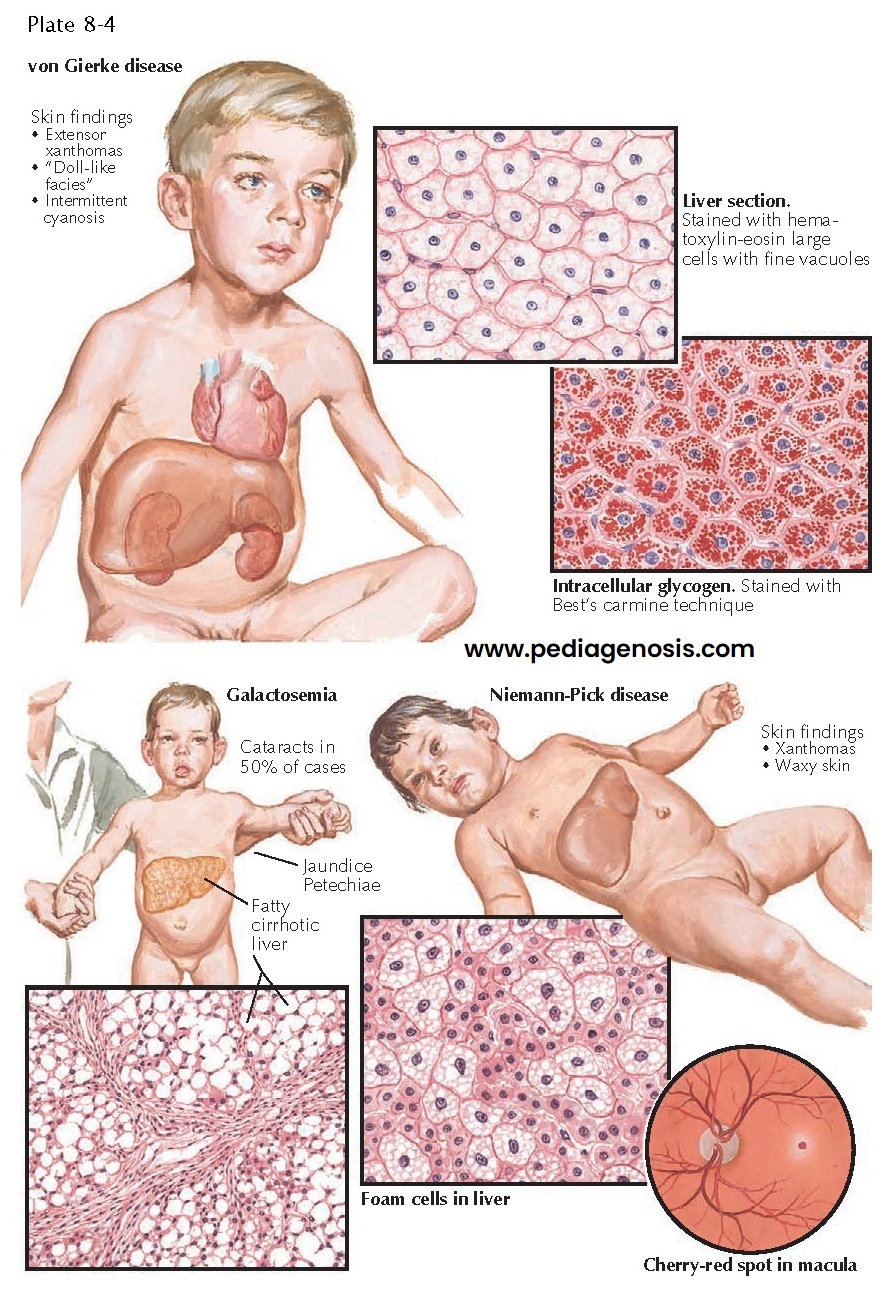METABOLIC DISEASES: NIEMANNPICK DISEASE,
VON GIERKE DISEASE,
AND GALACTOSEMIA
 |
| SELECTED METABOLIC DISEASES WITH SKIN FINDINGS |
There are a plethora of metabolic diseases that can have various cutaneous skin findings. These conditions, on the whole, are uncommon and are rarely encountered by the practitioner except in a tertiary referral center. However, knowledge of these uncommon diseases is important, because prompt recognition and diagnosis can lead to proper referrals and a better outcome for all involved. Three such metabolic disorders are Niemann-Pick disease, von Gierke disease, and galactosemia.
Niemann-Pick
disease is a heterogenous group of conditions resulting from inability to
properly metabolize sphingomyelin. There are three clinical variants, which
have been designated types A, B, and C. They are all inherited in an autosomal
recessive pattern, with the highest prevalence in people of Ashkenazi Jewish
descent. Most cases are fatal in early childhood. Mental delay is profound. The
disease results in massive hepatosplenomegaly caused by the excessive
accumulation of sphingomyelin in various tissues. Niemann-Pick disease is caused
by an abnormal lysosomal lipid enzyme degradation system, and it is therefore
considered to be a lysosomal storage disease. Sphingomyelin is degraded into
ceramide by the action of the enzyme sphingomyelinase. Type A and type B
disease are similar in that the ASM gene, which encodes the acid
sphingomyelinase enzyme, is mutated. This mutation leads to an inability of the
lysosomes to metabolize sphingomyelin. Sphingomyelin accumulates in the liver
and spleen. Severe neurological disorders occur in type A disease, but not in
type B, and this is the only factor differentiating the two. Patients present
in infancy or early child-hood. Skin findings include xanthomas and a waxy skin
surface. Retinal examination reveals a cherry-red spot on the fovea. Niemann-Pick
type C disease, which is caused by a mutation in the NPC1 or the NPC2
gene, does not involve any cutaneous findings. The cells are unable to
normally process endocytosed cholesterol. Treatments are limited, with stem
cell transplantation having been used with some efficacy. von Gierke
disease, also known as glycogen storage disease type I, can be
subdivided into types Ia and Ib. These autosomal recessive diseases are caused,
respectively, by defects in the enzymes glucose-6-phosphatase and
glucose-6-phosphatase translocase. These defects prevent normal gluconeogenesis
from glycogen stores. Patients develop profound hypoglycemia during periods of
fasting because they are unable to break down glucose-6-phosphate into glucose
within the liver. This leads to a fatty liver and increased glycogen storage.
Glucose-6-phosphate is shunted into glycolysis, which results in increased
lactate production.
Cutaneous
findings in von Gierke disease include extensor xanthomas on the knees and
elbows. Patients have a peculiar facies that has been described as a “doll-like
face.” This has been shown to be caused by an increased amount of fatty tissue
deposited in the cheeks. Patients have frequent nose bleeds and severe
gingivitis along with oral ulcerations. During periods of hypoglycemia,
cyanosis may be very noticeable, and it may lead eventually to hypoxic brain
injury. These patients are also at higher risk for skin infections due to an
abnormal neutrophilic response to gram-positive bacteria. Treatment is based on a
diet of 60% to 70% carbohydrates to avoid episodes of hypoglycemia.
Galactosemia is a rare autosomal recessive disorder that results from a defect in the enzyme galactose-1- phosphate uridyltransferase. It is caused by a mutation of the GALT gene on the short arm of chromosome 9. This mutation results in an increase of galactose-1- phosphate in various tissues. Nervous tissue, the lens, and the liver are areas of massive accumulation. This leads to the sequelae of the disease, predominantly mental delay, cataracts, and liver disease. The main cutaneous findings are jaundice secondary to liver disease and cutaneous signs of coagulopathy such as petechiae and hemorrhage. Cataracts are a well-known sign of galactosemia and are directly caused by the accumulation of galactitol in the lens, which results in edema and eventual cataract formation. Therapy requires he strict avoidance of galactose and lactose in the diet.




